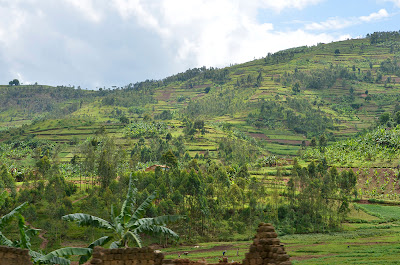Once out of Kigali it becomes clear why Rwanda is called the Land of a Thousand Hills.
It's very very hilly and very very pretty, with the deep valleys covered with little farms growing vegetables and corn. The steep walls of the valleys are heavily terraced and little farming plots and banana plantations cling to the hillsides. The sun glints off the rooftops of the little farmhouses in their new tin roofs, courtesy of a recent government initative which saw all the old thatched roofs replaced with metal. In some valleys there are rectangular ponds where fish are bred. The ponds are bordered by rabbit hutches, and the rabbit droppings fall into the water to feed the fish.
Leaving Kigali is like stepping 100 years back in time. A constant stream of people of all ages walking along the road in both directions - sometimes beside, often on it. Women dressed in colourful long wrap-around skirts and scarves carrying all sorts of bundles on their heads. Kids playing beside the road waving to us as we go past. Young men standing in groups with their bikes waiting to pick up a bit or work, or just standing watching traffic go past. In the fields people hoeing and weeding just as they might have done for centuries.
Bikes are a principal form of transport and carry everything from people (as a sort of local taxi), to big sacks of potatoes, building materials, timber, logs and car parts.
Josien stopped to show us a panoramic view of the River Nyabarongo, not far out of Kigali. The Nyabarongo is now considered by many to be the true source of the Nile (at least the most distant from the sea). This spot has a rather dark history, as during the Genocide, thousands of Tutsis were either drowned here or killed and their bodies thrown into the river to float downstream. Hutu extremists had come up with a theory that the Tutsis originated in Ethiopa and that throwing them in the Nyabarongo would return them to whence they came.
 |
| Nyabarongo River, source of the Nile and site of one of the massacres during the Genocide |
The road was good most of the way, and there was a lot of roadwork going on, usually under the direction of Chinese foremen, as the Chinese government is providing a lot of aid in the form of expertise and assistance with roadbuiding.
We arrived at Ruhengeri in time for lunch, then on a further 30 minutes to the Iby’Iwacu cultural village where we were staying the night, right in the middle of the volcanoes. More about that and the adventures of King Ted and Queen Julie in the next post.






Aucun commentaire:
Enregistrer un commentaire